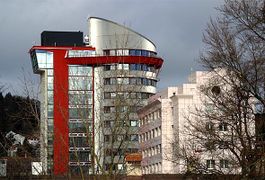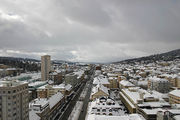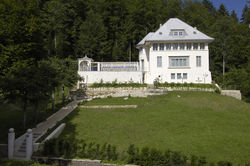La Chaux-de-Fonds
| La Chaux-de-Fonds | ||||||||||
|---|---|---|---|---|---|---|---|---|---|---|
 |
||||||||||
|
||||||||||
| Population | 37,413 (Dec 2009)[1] | |||||||||
| - Density | 672 /km2 (1,741 /sq mi) | |||||||||
| Area | 55.66 km2 (21.49 sq mi) | |||||||||
| Elevation | 1,000 m (3,281 ft) | |||||||||
| Postal code | 2300 | |||||||||
| SFOS number | 6421 | |||||||||
| Mayor | Jean-Pierre Veya PdA/PST | |||||||||
| Surrounded by | Fontaines, Fournet-Blancheroche (FR-25), Grand'Combe-des-Bois (FR-25), La Ferrière (BE), La Sagne, Le Locle, Les Bois (JU), Les Fontenelles (FR-25), Les Hauts-Geneveys, Les Planchettes, Renan (BE) | |||||||||
| Twin towns | Winterthur (Switzerland), Frameries (Belgium) | |||||||||
| Website | www.chaux-de-fonds.ch Profile (French), SFSO statistics |
|||||||||
 La Chaux-de-Fonds
|
||||||||||
| View map of La Chaux-de-Fonds | ||||||||||
| La Chaux-de-Fonds / Le Locle, watchmaking town planning* | |
|---|---|
| UNESCO World Heritage Site | |
| State Party | |
| Type | Cultural |
| Criteria | iv |
| Reference | 1302 |
| Region** | Europe and North America |
| Inscription history | |
| Inscription | 2009 (33rd Session) |
| * Name as inscribed on World Heritage List. ** Region as classified by UNESCO. |
|
La Chaux-de-Fonds is the capital city of the district of La Chaux-de-Fonds in the canton of Neuchâtel in Switzerland.
It is located in the Jura mountains at an altitude of 1000 m, a few kilometers from the French border. After Geneva and Lausanne, it is the third largest city in the French-speaking part of the country.
Contents |
Unesco World Heritage Sites
The watch making cities of La Chaux-de-Fonds and Le Locle have jointly received recognition from UNESCO for their exceptional universal value.
The Site's planning consists of two small cities located close to each other in the mountainous environment of the Swiss Jura. Due to the altitude (1'000 meters up) and the lack of water (porous sandstone underground) the land is ill suited to farming. Planning and buildings reflect the watch making artisans need of rational organization. Rebuilt in the early 19th Century, after extensive fires, both towns owe their survival to the manufacturing and exports of watches, to which, in the 20th Century, was added the minute micromechanical industry.
Along an open-ended scheme of parallel strips on which residential housing and workshops are intermingled, their town planning reflects the needs of the local watch making culture that dates back to the 17th century, which still alive today. Both agglomerations present outstanding examples of mono-industrial manufacturing-towns, which are still well preserved and active. Their urban planning has accommodated the transition from the artisans’ production of a cottage industry to the more concentrated factory production of the late 19th and 20th centuries. Already Karl Marx described La Chaux-de-Fonds as a “huge factory-town” in Das Kapital, where he analyzed the division of labour in the watch making industry of the Jura.
It is the tenth Swiss Site to be awarded World Heritage status, joining others such as the Old City of Berne, the Rhaetian Railway and the Abbey and Convent of St. Gallen.
Source: [1]
History
The region was first inhabited around 10,000 years ago (Epipaleolithic). A skull and other traces have been found in caves nearby.

In the middle of the 14th century, the forests found there have been colonised from the south. The region was under the authority of the lords of Valangin. Agriculture was the main activity. The first church was built in 1528. The city became at the end of the 16th century an important crossroad between Neuchâtel and Franche-Comté.
The community grew during the Thirty Years' War, mainly because of its strategic position for trade. But economic activity really begins in the 18th century with the development of lace and watchmaking industry. Pierre Jacquet-Droz and his family is one of the most famous watchmakers of this time. He is best known for his automata.
In 1794, the city was devastated by fire. Charles-Henri Junod created the new city's plan in 1835, and the city is now known for its "modern," grid-like plan, in comparison with most European cities' meandering streets.[2][3] The central avenue is named the Avenue Léopold Robert.
Culture

La Chaux-de-Fonds is the home of the Musée International d'Horlogerie (International Museum of Watch Making), originally constructed with funds donated by the Gallet watchmaking family in 1899. The Museum is considered as an important showcase for the history of the timekeeping arts[4].
Art Nouveau had a great influence on architecture and culture in the city during the late 19th century.
The daily newspaper L'Impartial has been published in La Chaux-de-Fonds since 1880.
The Wakker Prize was granted to La-Chaux-de-Fonds in 1994.
Economy
The city's economy is based on industry and watch manufacturers. Famous watchmaking manufacturers include Cartier, Girard-Perregaux founded in Geneva in 1791, TAG Heuer, Corum, Breitling, Juvenia, the British Masters, Movado, Ulysse Nardin, Invicta, Gallet, Bell & Ross and others.
Transport
The city is served by Les Eplatures Airport and has a trolleybus transport system.
Weather
| Climate data for La-Chaux-de-Fonds | |||||||||||||
|---|---|---|---|---|---|---|---|---|---|---|---|---|---|
| Month | Jan | Feb | Mar | Apr | May | Jun | Jul | Aug | Sep | Oct | Nov | Dec | Year |
| Source: MeteoSchweiz [5] | |||||||||||||
Notable people
Its most famous native sons are the architect Le Corbusier, born here as Charles-Edouard Jeanneret in 1887 (his first independent project as an architect, the Villa Jeanneret-Perret, is open to the public), Louis Chevrolet, born in 1878, founder of the Chevrolet Motor Car Company and Blaise Cendrars, novelist and poet, born as Frédéric Louis Sauser in 1887.
Other notable people born in La Chaux-de-Fonds include Armand Borel, a mathematician, Louis-Leopold Robert, a painter, born in 1794, Numa Droz, a politician, born in 1844, and Adrienne von Speyr, a modern Catholic mystic, born in 1902.
Watch companies
Many watch companies started in La Chaux de Fonds:
- Gallet & Co., by Julien Gallet, in 1826.
- Heuer Leonidas, now TAG Heuer, by Edouard Heuer, in 1860
- Invicta Watch Group, founded by Raphael Picard, in 1837.
- Bouchet-Lassale SA, in 1978.
- Movado by Achilles Ditesheim, in 1881 .
- Omega SA, in 1848.
- Rolex trademark, registered by Hans Wilsdorf, in 1908. His company, Wilsdorf & Davis, London, was later renamed Rolex Watch Company, Geneva and Biel/Bienne.
- Rotary by Moise Dreyfuss, in 1895
- Girard-Perregaux by Constantin Girard and Marie Perregaux, in 1856
References
- ↑ Swiss Federal Statistical Office, MS Excel document – Bilanz der ständigen Wohnbevölkerung nach Kantonen, Bezirken und Gemeinden (German) accessed 25 August 2010
- ↑ The Le Corbusier Guide, Google Books
- ↑ La Chaux-de-Fonds et le Locle, Swiss Tourism Site
- ↑ Catherine Cardinal, Jean-Michael Piquet, Catalogue of Selected Pieces, Institut l'homme et le temps, pg. 5
- ↑ "Temperature and Percipitation Average Values-Table, 1961-1990" (in German, French, Italian). Federal Office of Meteorology and Climatology MeteoSwiss. http://www.meteoswiss.admin.ch/web/de/klima/klima_schweiz/tabellen.html. Retrieved 8 May 2009.
External links
- Watchmaking Heritage Day: Saturday 7 November 2009
- Official website of the City of La Chaux-de-Fonds
- La Chaux-de-Fonds / Le Locle: Pictures Gallery
- La Chaux-de-Fonds in German, French and Italian in the online Historical Dictionary of Switzerland.
- International watchmaking museum website
- The Art Nouveau season of events in the city
|
|||||||
|
||||||||||||||||||||
